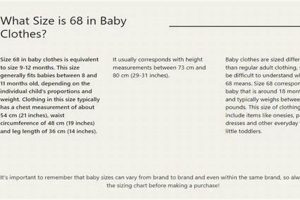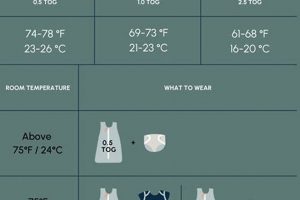European garment sizing for infants designates “68” as corresponding to an approximate height of 68 centimeters. These garments are typically intended for babies around six months of age, though individual growth rates can vary. Clothing labeled with this measurement generally accommodates the physical dimensions of infants within that height range, ensuring a comfortable and functional fit.
Proper fit is crucial for infant well-being and development. Garments that are too restrictive can impede movement and potentially affect motor skill development. Overly large attire presents safety hazards and can hinder comfort. Selecting apparel that corresponds to the infant’s physical measurements ensures freedom of movement and promotes overall well-being. This sizing standard provides a valuable reference point for caregivers when selecting appropriate attire.
With a clear understanding of infant garment sizing, a more detailed exploration of specific factors influencing garment selection can proceed. Subsequent discussions will address the impact of materials, design, and seasonal considerations on optimal infant clothing choices. These factors play a vital role in ensuring the comfort, safety, and overall well-being of the infant.
Guidance on Selecting Infant Apparel
The following recommendations provide practical assistance in choosing appropriately sized garments for infants, based on standardized sizing conventions.
Tip 1: Prioritize accurate measurement. Measure the infant’s height from head to heel. This measurement should be compared to sizing charts to determine the most appropriate garment size. Disregarding this step may result in purchasing items that do not fit correctly.
Tip 2: Consider the manufacturer’s sizing chart. While standardized sizing exists, subtle variations between manufacturers can occur. Always consult the specific brand’s sizing chart for increased accuracy.
Tip 3: Account for diaper bulk. Diapers add bulk to the infant’s lower body. When selecting clothing, ensure sufficient room in the crotch and leg areas to accommodate the diaper comfortably. Restrictive garments in these areas can cause discomfort and skin irritation.
Tip 4: Opt for adjustable features. Garments with adjustable features, such as snaps or elastic waistbands, can provide a more customized fit and extend the garment’s usability as the infant grows.
Tip 5: Assess fabric elasticity. Stretchy fabrics offer greater flexibility and comfort. Evaluate the elasticity of the fabric to ensure ease of movement and a comfortable fit. Avoid overly rigid or restrictive materials.
Tip 6: Monitor for signs of discomfort. Observe the infant for signs of discomfort, such as redness, chafing, or restricted movement. These indicators suggest the garment is not appropriately sized or designed.
Tip 7: Err on the side of slightly larger. When in doubt, selecting a slightly larger size is preferable to a smaller size. Infants grow rapidly, and a garment that is slightly too large will be wearable for a longer period.
Selecting appropriately sized garments, based on accurate measurements and careful consideration of garment features, contributes significantly to the infant’s comfort and well-being.
A focus on these guidelines is essential to ensuring the proper fit and functionality of the items chosen for the child.
1. Centimeters (height)
The measurement of an infant’s height in centimeters forms the foundational basis for determining appropriate garment sizing, particularly within the European standard where “size 68” is prevalent. This metric serves as the primary indicator for selecting clothing that aligns with the infant’s physical dimensions, ensuring a proper and comfortable fit.
- Standardized Measurement
Centimeters provide a standardized unit of measurement for accurately determining an infant’s height. This allows for consistent sizing across different manufacturers adhering to the European standard. Without this standardized unit, variations in sizing would be significantly more pronounced, leading to greater difficulty in selecting appropriate garments. For example, an infant measuring precisely 68 centimeters aligns directly with the “size 68” designation.
- Developmental Milestone Correlation
Height in centimeters correlates with various developmental milestones typically achieved around six months of age. While individual variation exists, the “size 68” designation generally corresponds with an infant’s ability to sit unassisted or engage in early stages of crawling. Apparel designed for this height range often incorporates features that accommodate these developmental activities, such as reinforced knees in trousers or flexible fabrics for ease of movement.
- Garment Construction Considerations
The specified height in centimeters influences garment construction. Designers and manufacturers use this measurement to determine the overall length, width, and sleeve length of the garment. For instance, the crotch depth in a bodysuit or the leg length in pants will be directly proportional to the 68-centimeter target height. This ensures that the garment fits comfortably and allows for adequate range of motion without being excessively large or restrictive.
- Growth Monitoring Tool
Regularly measuring an infant’s height in centimeters provides valuable data for monitoring growth patterns. Deviations from expected growth curves may indicate underlying health concerns that warrant medical attention. Furthermore, consistent tracking of height allows caregivers to anticipate when an infant will outgrow their current wardrobe and necessitates purchasing larger sizes, maintaining optimal comfort and proper fit.
These facets of height measurement in centimeters underscore its central role in the “size 68” garment designation. By understanding the standardized unit, developmental correlations, construction considerations, and growth monitoring applications, caregivers can make informed decisions when selecting clothing, ensuring a comfortable and appropriate fit for the infant’s developmental stage.
2. Six months (approximate age)
The designation “six months (approximate age)” serves as a general guideline for determining the suitability of “size 68” garments for infants. Growth trajectories vary significantly among individuals, rendering age merely an estimated correlation rather than a definitive indicator. The average six-month-old infant typically measures around 68 centimeters in height, aligning with this European sizing convention. However, genetic predispositions, nutritional intake, and environmental factors contribute to diverse growth rates, resulting in discrepancies between chronological age and physical size. For instance, a breastfed infant may exhibit different growth patterns compared to a formula-fed infant, affecting their height at six months. Relying solely on age for garment selection is therefore insufficient; accurate height measurement is paramount.
While age provides an initial reference point, its practical application is limited by the inherent variability in infant development. A six-month-old infant born prematurely may require smaller garments, even if their chronological age suggests otherwise. Conversely, a six-month-old infant with a genetic predisposition for accelerated growth may necessitate larger sizes. Furthermore, garment manufacturers utilize “six months” as a marketing tool to categorize their products, but this classification does not guarantee a perfect fit for all infants within that age range. Careful consideration of both height and individual growth patterns is crucial for optimal garment selection.
In summary, “six months (approximate age)” functions as a preliminary indicator for “size 68” garments, but its inherent limitations necessitate a more comprehensive assessment. Height measurement, coupled with an understanding of individual growth variations, is essential for ensuring proper fit and comfort. Challenges arise from the oversimplification of growth patterns based on age alone, highlighting the importance of individualized assessment and critical evaluation of manufacturer sizing guidelines. This understanding promotes more informed and accurate garment selection, contributing to enhanced infant well-being.
3. European standard
The designation “size 68 in baby clothes” is directly linked to the European standard for clothing sizes, which utilizes a numerical system based on the child’s height in centimeters. This standard aims to provide a more accurate and consistent method of sizing compared to age-based systems, though age ranges are often loosely associated. The standardization offers manufacturers a unified framework for producing garments, and consumers a more reliable means for selecting appropriately sized items. Without the European standard, “size 68” would lack a consistent definition, resulting in significant discrepancies between brands and difficulties in ensuring a proper fit. For example, a garment labeled “size 68” from one European manufacturer is expected to adhere to similar height and dimension specifications as another European manufacturer adhering to the same standard.
The practical application of the European standard in this context is evident in its impact on garment design and manufacturing processes. Manufacturers develop patterns and sizing charts that align with the specified measurements associated with each numerical size. Retailers utilize these standardized sizes to categorize and display products, facilitating easier navigation for consumers. Caregivers benefit from the comparative reliability of the system, as they can measure their child’s height and then confidently select garments corresponding to that measurement, reducing the need for trial and error or relying solely on imprecise age estimations. However, variations can still exist between brands due to stylistic choices or specific design elements.
In summary, the European standard provides a foundational framework for “size 68 in baby clothes,” establishing a height-based numerical system that promotes consistency and facilitates more accurate garment selection. While acknowledging residual variations between manufacturers, the standard offers a valuable and relatively reliable system for sizing compared to age-based alternatives. A full understanding of the relationship between height measurements and garment size charts remains crucial for caregivers to ensure optimal fit and comfort for infants.
4. Growth variation
Growth variation constitutes a critical factor in determining the suitability of “size 68 in baby clothes” for individual infants. While “size 68” is typically associated with infants around six months of age or approximately 68 centimeters in height, individual growth trajectories differ significantly. These variations stem from a combination of genetic predispositions, nutritional factors, and environmental influences, leading to a range of heights and body proportions within the same age group. Consequently, relying solely on age or the generalized size designation may result in ill-fitting garments, potentially impacting the infant’s comfort and mobility. For example, a six-month-old infant with a familial history of taller stature may require a larger size, despite falling within the average age range associated with “size 68”. Conversely, a six-month-old infant born prematurely may still require a smaller size to achieve a proper fit.
Recognizing the impact of growth variation necessitates a shift from relying on age-based sizing to prioritizing accurate height measurement. Caregivers should routinely measure the infant’s height in centimeters and compare it to the specific size charts provided by garment manufacturers. These charts offer more granular details regarding the garment’s dimensions, including chest circumference, sleeve length, and inseam, allowing for a more precise fit. Furthermore, awareness of growth variation underscores the importance of selecting garments with adjustable features, such as adjustable waistbands or shoulder snaps, to accommodate individual body shapes and allow for continued use as the infant grows. A caregiver who observes that the “size 68” garment is too tight around the chest, despite being the correct length, can opt for a larger size or a garment with a more generous chest measurement to ensure comfort and freedom of movement.
In conclusion, growth variation introduces significant complexity to infant garment sizing, rendering age-based designations inadequate for ensuring a proper fit. Emphasizing accurate height measurement, consulting manufacturer size charts, and selecting garments with adjustable features are crucial strategies for navigating these variations and optimizing the infant’s comfort and well-being. The challenge lies in overcoming the convenience of generalized sizing and adopting a more individualized approach to garment selection, acknowledging that each infant’s growth pattern is unique and warrants careful consideration. This approach ensures that the selected apparel effectively supports the infant’s physical development and comfort.
5. Comfort crucial
The principle of infant comfort directly influences the selection and suitability of “size 68 in baby clothes”. Garment choice must prioritize the infant’s well-being by ensuring unrestricted movement and preventing skin irritation or discomfort. This consideration extends beyond mere aesthetic appeal and encompasses the physiological needs of the developing infant.
- Material Selection and Breathability
Material composition plays a pivotal role in ensuring infant comfort. Fabrics must exhibit breathability to regulate body temperature and minimize the risk of overheating or chilling. Natural fibers, such as cotton, are often preferred due to their absorbent properties and soft texture, which reduces the likelihood of skin irritation. Conversely, synthetic materials may restrict airflow and cause discomfort, particularly in warmer environments. A “size 68” garment constructed from tightly woven, non-breathable fabric would negate the benefits of an appropriate size, leading to discomfort and potential skin conditions.
- Seam Construction and Placement
The construction and placement of seams significantly impact comfort. Minimizing the presence of bulky or abrasive seams, particularly in areas of high friction, such as the underarms or crotch, is essential. Flatlock seams, which lie flat against the skin, are often employed to reduce irritation. Internal labels should be avoided or constructed from soft materials to prevent scratching. A “size 68” garment with poorly placed or constructed seams could cause chafing and discomfort, even if the overall size is appropriate.
- Fit and Range of Motion
The fit of a garment must allow for unrestricted movement. Infants require ample freedom to explore their environment and develop motor skills. A “size 68” garment that is too tight or constricting can impede movement and potentially hinder development. Conversely, an overly large garment may pose safety hazards. The garment must allow for a full range of motion without binding or restricting any part of the body. For example, an appropriately sized garment will permit the infant to kick, stretch, and roll over comfortably.
- Absence of Irritants
Comfort also encompasses the absence of irritants, such as chemical residues from dyes or finishes. Garments should be washed prior to first use to remove any residual chemicals that could cause allergic reactions or skin sensitivities. Choosing garments made with hypoallergenic materials and avoiding those treated with harsh chemicals contributes to overall comfort. A “size 68” garment manufactured with substandard dyes could trigger skin irritation, even if the size and fabric are otherwise suitable.
In conclusion, “comfort crucial” is intrinsically linked to the appropriate selection of “size 68 in baby clothes.” This entails careful consideration of material composition, seam construction, fit, and the absence of irritants. Prioritizing these aspects ensures that the selected garment not only fits appropriately but also promotes the infant’s well-being and supports their development. Neglecting these comfort factors can have adverse effects on the infant’s physical and emotional state.
6. Movement freedom
The concept of movement freedom is intrinsically linked to the proper application of “size 68 in baby clothes.” Correct garment selection, aligned with appropriate sizing, directly facilitates unrestricted mobility, crucial for infant development. Constrictive clothing, even if superficially resembling the intended size, can impede the infant’s ability to explore their environment, practice motor skills, and maintain proper circulation. Conversely, garments that are too large can present entanglement hazards and hinder coordinated movement. The goal, therefore, is to achieve a balance where the clothing supports, rather than restricts, natural movement patterns. This balance is more readily attained through precise sizing informed by the infant’s height and individual proportions, adhering to, but not blindly following, the “size 68” guideline. A practical example involves observing an infant attempting to crawl while wearing undersized clothing. Restricted hip and knee movement due to tightness inhibits the crawling motion, potentially delaying or altering the development of this crucial motor skill.
Further analysis reveals that movement freedom affects not only physical development but also sensory exploration and cognitive growth. Infants learn through tactile experiences and interaction with their surroundings. Garments that limit the ability to reach, grasp, or manipulate objects can diminish these opportunities for learning. Furthermore, discomfort caused by restrictive clothing can lead to irritability and decreased attention span, hindering cognitive development. The selection of fabrics plays a critical role in supporting movement freedom. Elasticity and breathability contribute to a comfortable and unrestricted range of motion. Rigid or non-breathable materials can create resistance, impede circulation, and contribute to overheating, all of which negatively impact the infant’s comfort and freedom of movement.
In summary, the interplay between “movement freedom” and “size 68 in baby clothes” highlights the significance of precise sizing and thoughtful material selection. Challenges arise when caregivers prioritize aesthetics over functionality or rely solely on age-based sizing charts without considering individual growth patterns. Adopting an informed approach, encompassing accurate measurement, consideration of fabric properties, and observation of the infant’s response to the clothing, is essential for ensuring optimal movement freedom and supporting healthy development. The understanding that correctly sized clothing supports, rather than hinders, natural movement patterns is paramount to responsible infant care.
Frequently Asked Questions
This section addresses common inquiries regarding the application and suitability of size 68 garments for infants. The information provided aims to clarify sizing conventions and promote informed purchasing decisions.
Question 1: What is the typical age range associated with size 68 baby clothes?
Size 68 garments generally correspond to infants around six months of age. However, individual growth rates vary significantly, necessitating reliance on height measurements rather than age alone.
Question 2: How is size 68 determined within the European sizing system?
The number “68” represents the infant’s approximate height in centimeters. This measurement serves as the primary determinant for garment sizing according to the European standard.
Question 3: Are there significant sizing variations between different brands offering size 68 garments?
While the European standard provides a general framework, minor sizing variations can occur between manufacturers due to stylistic differences or specific design choices. Consulting individual brand size charts is recommended.
Question 4: What factors beyond height should be considered when selecting size 68 garments?
In addition to height, caregivers should assess the infant’s overall body proportions, including chest circumference and limb length. Garment material, elasticity, and adjustability should also be evaluated.
Question 5: How can caregivers ensure that size 68 garments allow for adequate movement freedom?
Garments should permit unrestricted movement of the limbs and torso. Caregivers should observe the infant for signs of discomfort or restricted mobility while wearing the garment.
Question 6: What are the potential consequences of selecting incorrectly sized garments for infants?
Overly restrictive garments can impede movement, potentially hindering motor skill development and causing skin irritation. Overly large garments may pose safety hazards and interfere with coordinated movement.
Accurate height measurement, consideration of individual body proportions, and adherence to manufacturer size charts are crucial for ensuring proper fit and maximizing infant comfort and well-being.
The subsequent section will explore specific garment features that contribute to optimal comfort and functionality.
Conclusion
This exploration has illuminated the complexities surrounding “size 68 in baby clothes.” While the designation implies an approximate height of 68 centimeters, typically associated with infants around six months of age, the inherent variations in growth necessitate a nuanced approach. Accurate measurement, careful consideration of individual body proportions, and adherence to manufacturer sizing charts are paramount for ensuring optimal fit and comfort. Furthermore, the selection of appropriate materials, seam construction, and garment adjustability contribute significantly to infant well-being.
The accurate application of sizing standards directly impacts infant comfort, mobility, and overall development. Therefore, caregivers must move beyond simplified age-based assumptions and adopt a comprehensive strategy for garment selection. Prioritizing these factors contributes to a more informed and responsible approach to infant care, promoting a healthier and more comfortable developmental environment. Continued attention to these details remains crucial as infants progress through subsequent growth stages.







